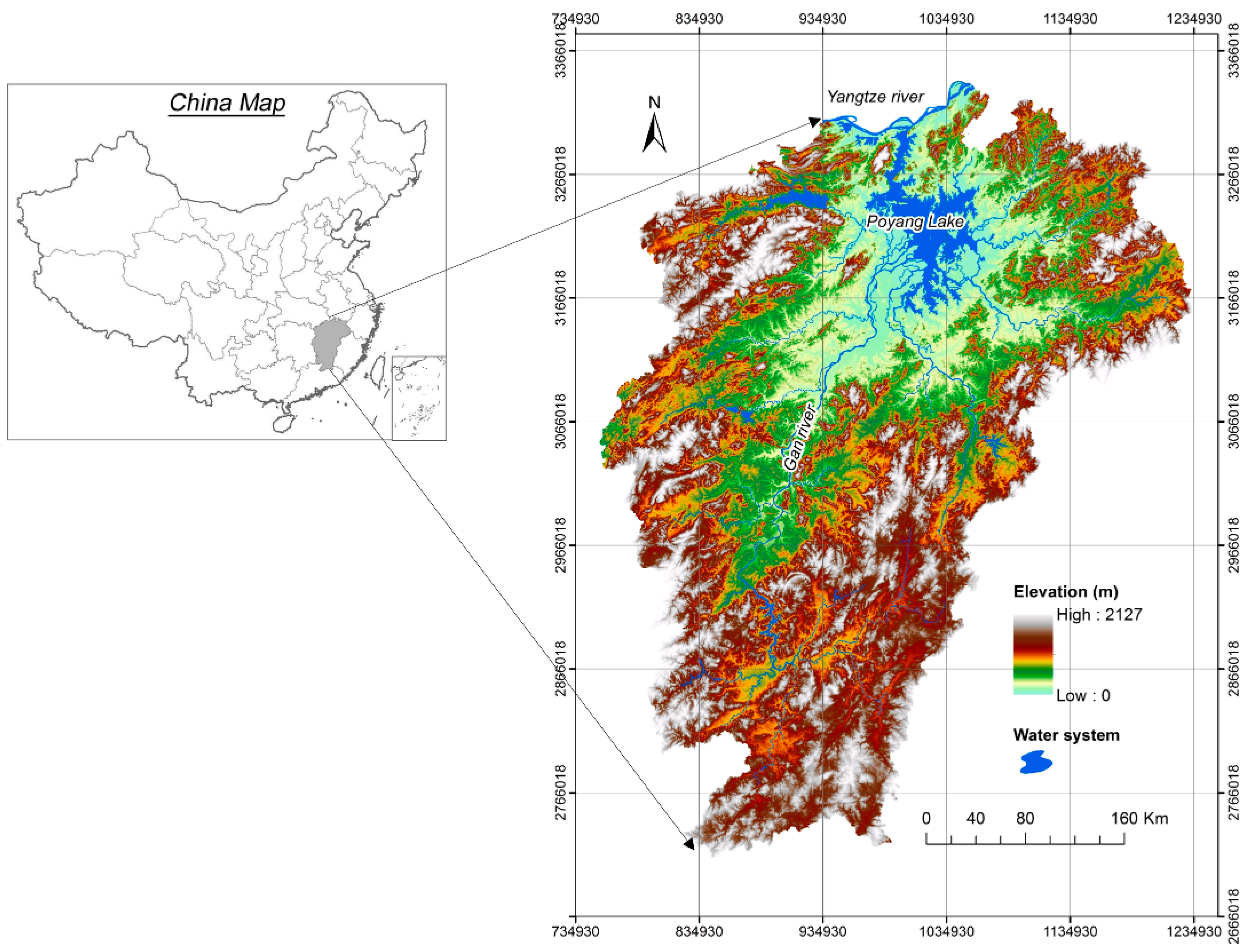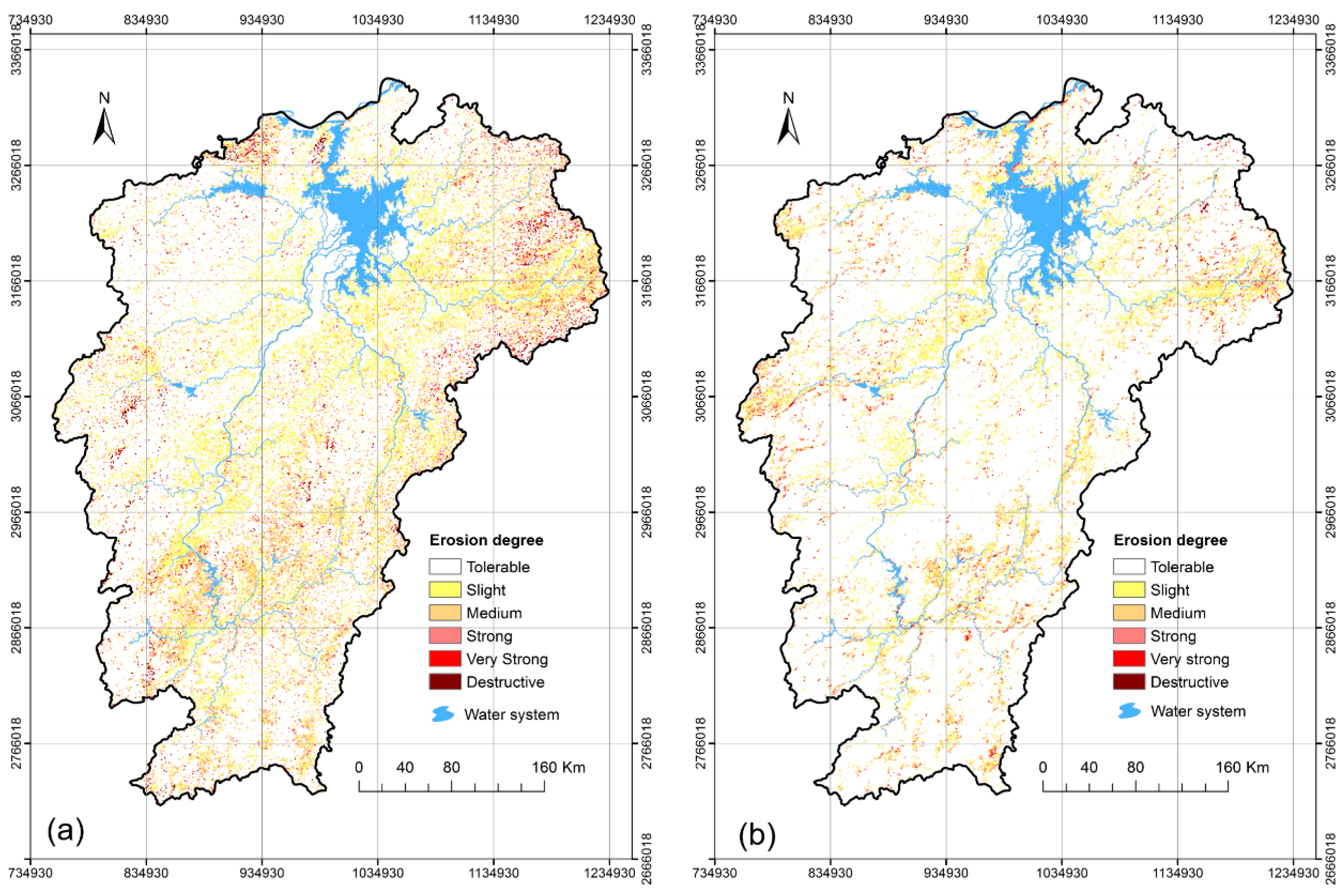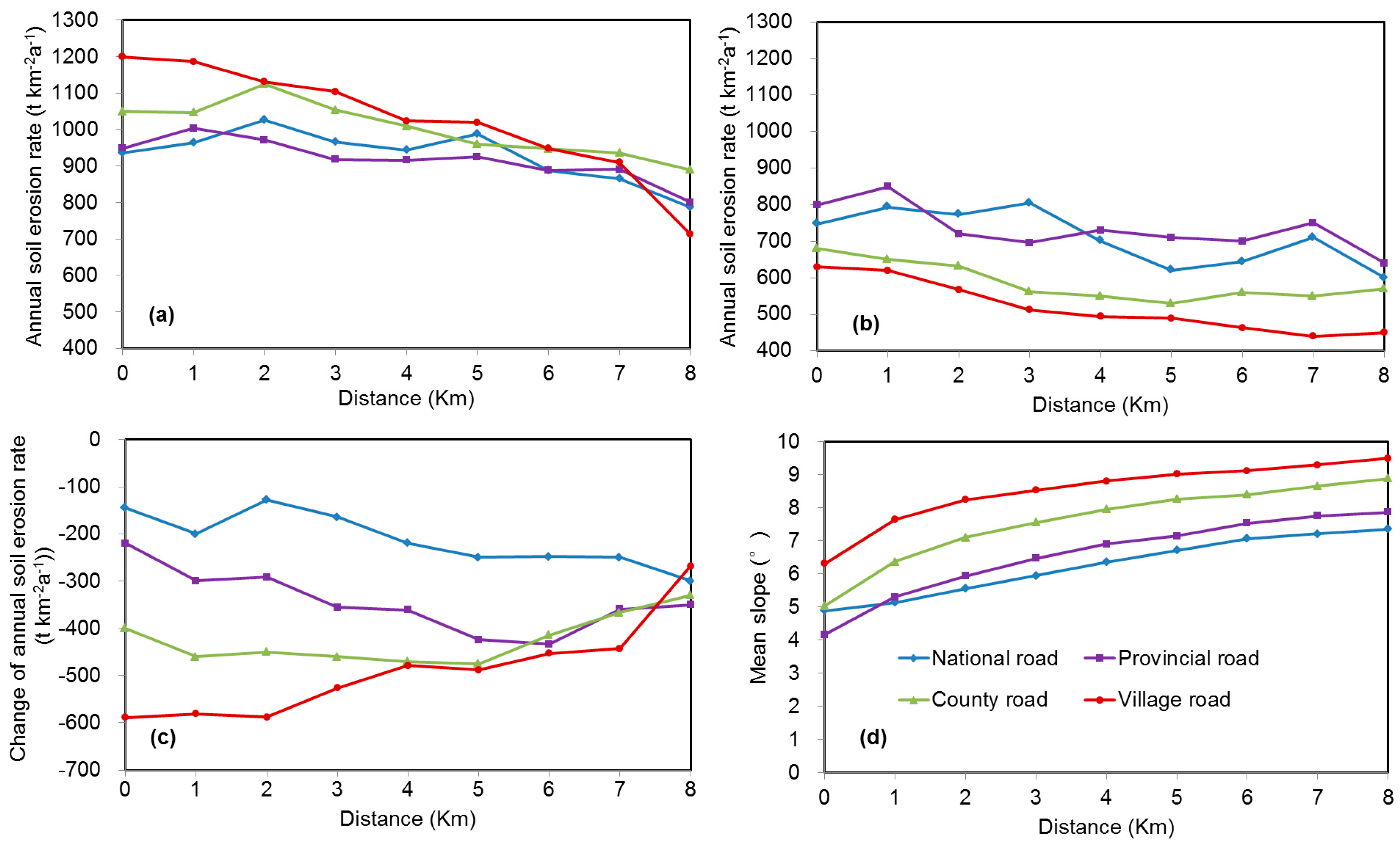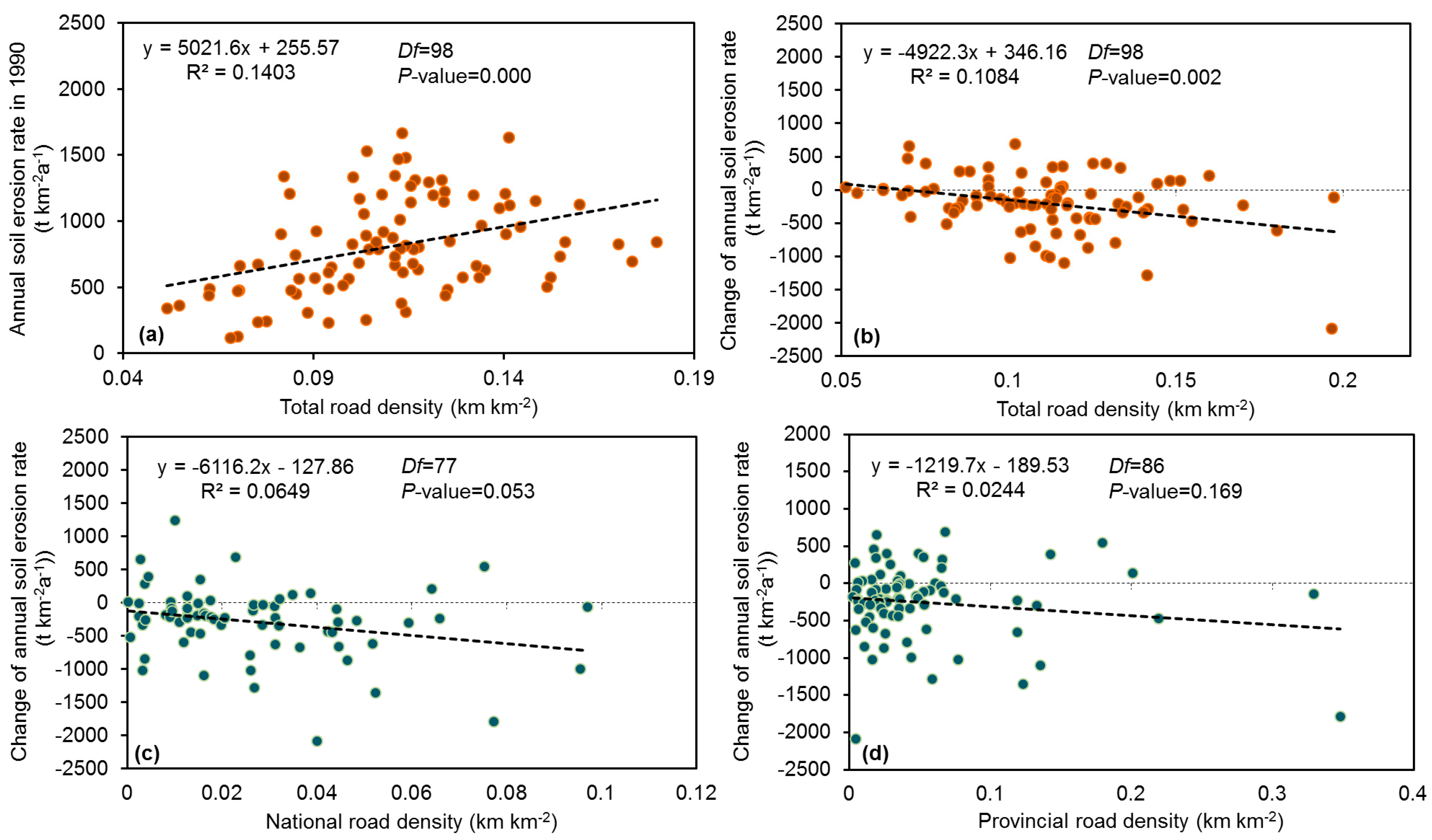The Indirect Roles of Roads in Soil Erosion Evolution in Jiangxi Province, China: A Large Scale Perspective
Abstract
:1. Introduction
2. Materials and Methods
2.1. Study Area
2.2. Materials
2.3. Methods
2.3.1. Estimation of Annual Soil Erosion Rate
2.3.2. Buffer Analysis and Regression Analyses
3. Results
3.1. Soil Erosion Intensity
3.2. Relationship between Soil Erosion and Distance to Roads
3.3. Relationship between Roil Erosion and Road Density
4. Discussion
4.1. The Soil Erosion Effects of Roads Are Strongly Associated with the Historical Policy and Economic Development Stage of the Study Area
4.2. The Soil Erosion Effects of Road Vary in Different Road Levels
5. Conclusions
Acknowledgments
Author Contributions
Conflicts of Interest
References
- Coffin, A.W. From roadkill to road ecology: A review of the ecological effects of roads. J. Transp. Geogr. 2007, 15, 396–406. [Google Scholar] [CrossRef]
- Mo, W.B.; Wang, Y.; Zhang, Y.Z.; Zhuang, D.F. Impacts of road network expansion on landscape ecological risk in a megacity, China: A case study of Beijing. Sci. Total Environ. 2017, 574, 1000–1011. [Google Scholar] [CrossRef] [PubMed]
- Cai, X.J.; Wu, Z.F.; Cheng, J. Using kernel density estimation to assess the spatial pattern of road density and its impacts on landscape fragmentation. Int. J. Geogr. Inf. Sci. 2013, 27, 222–230. [Google Scholar] [CrossRef]
- Martín, B.; Ortega, E.; Otero, I.; Arce, R.M. Landscape character assessment with GIS using map-based indicators and photographs in the relationship between landscape and roads. J. Environ. Manag. 2016, 180, 324–334. [Google Scholar] [CrossRef] [PubMed]
- Ji, S.N.; Jiang, Z.G.; Li, L.L. Impact of different road types on small mammals in Mt. Kalamaili Nature Reserve. Transp. Res. Part D 2017, 50, 223–233. [Google Scholar] [CrossRef]
- Trombulak, S.C.; Frissell, C.A. Review of ecological effects of roads on terrestrial and aquatic communities. Conserv. Biol. 2002, 14, 18–30. [Google Scholar] [CrossRef]
- Saeki, M.; Macdonald, D.W. The effects of traffic on the raccoon dog (Nyctereutes procyonoides viverrinus) and other mammals in Japan. Biol. Conserv. 2004, 118, 559–571. [Google Scholar] [CrossRef]
- Lee, M.L.; Power, S.A. Direct and indirect effects of roads and road vehicles on the plant community composition of calcareous grasslands. Environ. Pollut. 2013, 176, 106–113. [Google Scholar] [CrossRef] [PubMed]
- Liu, S.L.; Dong, Y.H.; Deng, L. Forest fragmentation and landscape connectivity change associated with road network extension and city expansion: A case study in the Lancang River valley. Ecol. Indic. 2014, 36, 160–168. [Google Scholar] [CrossRef]
- Hu, X.S.; Zhang, L.Y.; Ye, L.M.; Lin, Y.H.; Qiu, R.Z. Locating spatial variation in the association between road network and forest biomass carbon accumulation. Ecol. Indic. 2017, 73, 214–223. [Google Scholar] [CrossRef]
- Morschel, J.; Fox, D.M.; Bruno, J.F. Limiting sediment deposition on roadways: Topographic controls on vulnerable roads and cost analysis of planting grass buffer strips. Environ. Sci. Policy 2004, 7, 39–45. [Google Scholar] [CrossRef]
- Altrichter, M.; Boaglio, G.I. Distribution and relative abundance of peccaries in the Argentine Chaco: Associations with human factors. Biol. Conserv. 2004, 116, 217–225. [Google Scholar] [CrossRef]
- Liang, Y.; Yang, X.; Su, C.L.; Sun, B.; Pan, X.Z. EI-based analysis of variation and trends of soil erosion of red soil region on a county scale. Acta Pedol. Sin. 2009, 46, 24–29. (In Chinese) [Google Scholar]
- Xiao, L.L.; Yang, X.H.; Cai, H.Y. Responses of Sediment Yield to Vegetation Cover Changes in the Poyang Lake Drainage Area, China. Water 2016, 8, 1–16. [Google Scholar] [CrossRef]
- Xiao, L.L.; Yang, X.H.; Chen, S.X.; Cai, H.Y. An assessment of erosivity distribution and its influence on the effectiveness of land use conversion for reducing soil erosion in Jiangxi, China. Catena 2015, 125, 50–60. [Google Scholar] [CrossRef]
- Deng, L.; Shangguan, Z.P.; Li, R. Effects of the grain-for-green program on soil erosion in China. Int. J. Sediment Res. 2012, 27, 120–127. [Google Scholar] [CrossRef]
- Xiao, L.L.; Yang, X.H.; Cai, H.Y. Cultivated land changes and agricultural potential productivity in Mainland China. Sustainability 2015, 7, 11893–11908. [Google Scholar] [CrossRef]
- Liu, J.Y.; Liu, M.L.; Tian, H.Q.; Zhuang, D.F.; Zhang, Z.X.; Zhang, W. Spatial and temporal patterns of China’s cropland during 1990–2000: An analysis based on Landsat TM data. Remote Sens. Environ. 2005, 98, 442–456. [Google Scholar] [CrossRef]
- Renard, K.G.; Foster, G.R.; Weesies, G.A.; McCool, D.K.; Yoder, D.C. Predicting Soil Loss by Water: A Guide to Conservation Planning with the Revised Soil Loss Equation (RSULE); US Department of Agriculture: Washington, DC, USA, 1997; Volume 703.
- Šúri, M.; Cebecauer, T.; Hofierka, J.; Fulajtár, E. Soil erosion assessment of Slovakia at a regional scale using GIS. Ekológia (Bratislava) 2002, 21, 404–422. [Google Scholar]
- Liu, B.Y.; Nearing, M.A.; Risse, L.M. Slope gradient effects on soil loss for steeps lopes. Trans. ASAE 1994, 37, 1835–1840. (In Chinese) [Google Scholar] [CrossRef]
- Sharpley, A.N.; Williams, J.R. (Eds.) EPIC-Erosion/Productivity Impact Calculator: 1. Model Documentation; United States Department of Agriculture: Washington, DC, USA, 1990; Volume 235.
- Cai, C.F.; Ding, S.W.; Shi, Z.H. Study of applying USLE and geographical information system IDRISI to predict soil erosion in small watershed. J. Soil Water Conserv. 2000, 14, 19–24. (In Chinese) [Google Scholar]
- Zhang, W.B.; Xie, Y. Rainfall erosivity estimation using daily rainfall amounts. Sci. Geogr. Sin. 2002, 22, 705–711. (In Chinese) [Google Scholar]
- Shu, H.; Jiang, M.X. Evaluating soil erosion in Jiangxi province with USLE model and remote sensing technology during 1995–2005. China Environ. Sci. 2011, 31, 1197–1203. (In Chinese) [Google Scholar]
- Ministry of Water Resources of the People’s Republic of China. Standards for Classification and Gradation of Soil Erosion (SL 190–2007); China Standards Press: Beijing, China, 2007.
- Ahn, K.H.; Merwade, V. Quantifying the relative impact of climate and human activities on streamflow. J. Hydrol. 2014, 515, 257–266. [Google Scholar] [CrossRef]
- Cebecauer, T.; Hofierka, T. The consequences of land-cover changes on soil erosion distribution in Slovakia. Geomorphology 2008, 98, 187–198. [Google Scholar] [CrossRef]
- Zhang, S.H.; Fan, W.W.; Li, Y.Q. The influence of changes in land use and landscape patterns on soil erosion in a watershed. Sci. Total Environ. 2017, 574, 34–45. [Google Scholar] [CrossRef] [PubMed]
- Shi, X.Z.; Liang, Y.; Gong, Z.T. Biological practices and soil conservation in Southern China. J. Crop Prod. 2000, 3, 41–48. [Google Scholar] [CrossRef]
- Zhang, L.X.; Hu, Q.H.; Wang, C.B. Rural energy in China: Pattern and policy. Trans. Chin. Soc. Agric. Eng. 2011, 27, 1–9. [Google Scholar] [CrossRef]
- Wang, X.H.; Hao, X.R.; Jin, L. Study on rural household energy consumption in China based on household investigation from typical counties. Trans. Chin. Soc. Agric. Eng. 2014, 30, 206–212. [Google Scholar]
- Shi, X.Z.; Wang, K.; Warner, E.D.; Yu, D.S.; Wang, H.J.; Yang, R.W.; Liang, Y.; Shi, D.M. Relationship between soil erosion and distance to roadways in undeveloped areas of China. Catena 2008, 72, 30–313. [Google Scholar] [CrossRef]
- Xu, E.Q.; Zhang, H.Q.; Li, M.X. Mining spatial information to investigate the evolution of karst rocky desertification and its human driving forces in Changshun, China. Sci. Total Environ. 2013, 458–460, 419–426. [Google Scholar] [CrossRef] [PubMed]
- Kosmas, C.; Gerontidis, S.T.; Marathianou, M. The effect of land use change on soils and vegetation over various lithological formations on Lesvos (Greece). Catena 2000, 40, 51–68. [Google Scholar] [CrossRef]
- Zhang, C.L.; Xie, S.H.; Zeng, J.L. Investigation on the state and prevention of artificial soil erosion in Jiangxi Province. Trans. CSAE 2008, 24, 54–57. (In Chinese) [Google Scholar]
- Boardman, J.; Bateman, S.; Seymour, S. Understanding the influence of farmer motivations on changes to soil erosion risk on sites of former serious erosion in the South Downs National Park, UK. Land Use Policy 2017, 60, 298–312. [Google Scholar] [CrossRef]
- Koulouri, M.; Giourga, C. Land abandonment and slope gradient as key factors of soil erosion in Mediterranean terraced lands. Catena 2007, 69, 274–281. [Google Scholar] [CrossRef]
- Li, M.A.; Yao, W.Y.; Li, Z.B.; Liu, P.L.; Shen, Z.Z. Effects of landforms on the erosion rate in a small watershed by the 137Cs tracing method. J. Environ. Radioact. 2010, 101, 380–384. [Google Scholar] [CrossRef] [PubMed]
- Feng, X.M.; Wang, Y.F.; Chen, L.D.; Fu, B.J.; Bai, G.S. Modeling soil erosion and its response to land-use change in hilly catchments of the Chinese Loess Plateau. Geomorphology 2010, 118, 239–248. [Google Scholar] [CrossRef]
- Narayanaraj, G.; Wimberly, M.C. Influences of forest roads on the spatial patterns of human- and lightning-caused wildfire ignitions. Appl. Geogr. 2012, 32, 878–888. [Google Scholar] [CrossRef]
- Chas-Amil, M.L.; Touza, J.; García-Martínez, E. Forest fires in the wildland-urban interface: A spatial analysis of forest fragmentation and human impacts. Appl. Geogr. 2013, 43, 127–137. [Google Scholar] [CrossRef]
- Dotterweich, M.; Stankoviansky, M.; Minár, J.; Koco, Š.; Papčo, P. Human induced soil erosion and gully system development in the Late Holocene and future perspectives on landscape evolution: Myjava Hill Land, Slovakia. Geomorphology 2013, 201, 227–245. [Google Scholar] [CrossRef]
- Parsakhoo, A.; Lotfalian, M.; Kavian, A. Prediction of the soil erosion in a forest and sediment yield from road network through GIS and SEDMODL. Int. J. Sediment Res. 2014, 29, 118–125. [Google Scholar] [CrossRef]
- Liu, Y.J.; Hu, J.M.; Wang, T.W. Effects of vegetation cover and road-concentrated flow on hillslope erosion in rainfall and scouring simulation tests in the Three Gorges Reservoir Area, China. Catena 2016, 136, 108–117. [Google Scholar] [CrossRef]








| Road Levels | Description |
|---|---|
| National | Main roadways providing access between important political and large economic centers. |
| Provincial | Main roadways connecting political cities, economic centers, and large mining areas. |
| County | Main roadways providing access from the county seats to other counties or undeveloped cities. |
| Village | Branch roads linking villages and relating closely to the daily lives of rural residents. |
| Factors | Input Data | Method |
|---|---|---|
| R | Meteorological data | Zhang and Xie, 2002 [24] |
| K | Soil survey data | Sharpley and Williams, 1990 [22] |
| LS | Digital Elevation Model | Liu et al., 1994 [21] |
| C | NDVI | Cai et al., 2000 [23] |
| P | Land use map | Shu and Jiang, 2011 [25] |
| Erosion Degrees | Area (km2) | Area Change (km2) | Relative Change a (%) | |
|---|---|---|---|---|
| 1990 | 2010 | |||
| Tolerable | 121,463 | 139,953 | 18,490 | 15.2 |
| Slight | 25,164 | 14,675 | −10,489 | −41.6 |
| Medium | 11,823 | 8076 | −3,747 | −31.6 |
| Strong | 6384 | 3307 | −3077 | −48.2 |
| Very strong | 1330 | 793 | −537 | −40.3 |
| Destructive | 755 | 115 | −640 | −84.7 |
| Year | Road Levels | Correlation Model | R2 | p |
|---|---|---|---|---|
| 1990 | National | Y = −19.11X + 1025.2 | 0.52 | 0.027 |
| Provincial | Y = −18.12X + 1008.4 | 0.74 | 0.003 | |
| County | Y = −23.70X + 1120.5 | 0.77 | 0.002 | |
| Village | Y = −53.80X + 1295.2 | 0.91 | 0.000 | |
| 2010 | National | Y = −21.38X + 817.57 | 0.60 | 0.015 |
| Provincial | Y = −16.10X + 813.43 | 0.51 | 0.030 | |
| County | Y = −15.26X + 663.31 | 0.63 | 0.011 | |
| Village | Y = −24.86X + 642.97 | 0.92 | 0.000 |
© 2017 by the authors; licensee MDPI, Basel, Switzerland. This article is an open access article distributed under the terms and conditions of the Creative Commons Attribution (CC-BY) license (http://creativecommons.org/licenses/by/4.0/).
Share and Cite
Xiao, L.; Yang, X.; Cai, H. The Indirect Roles of Roads in Soil Erosion Evolution in Jiangxi Province, China: A Large Scale Perspective. Sustainability 2017, 9, 129. https://doi.org/10.3390/su9010129
Xiao L, Yang X, Cai H. The Indirect Roles of Roads in Soil Erosion Evolution in Jiangxi Province, China: A Large Scale Perspective. Sustainability. 2017; 9(1):129. https://doi.org/10.3390/su9010129
Chicago/Turabian StyleXiao, Linlin, Xiaohuan Yang, and Hongyan Cai. 2017. "The Indirect Roles of Roads in Soil Erosion Evolution in Jiangxi Province, China: A Large Scale Perspective" Sustainability 9, no. 1: 129. https://doi.org/10.3390/su9010129






